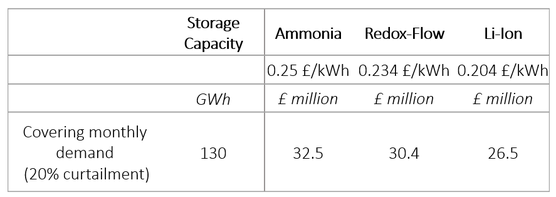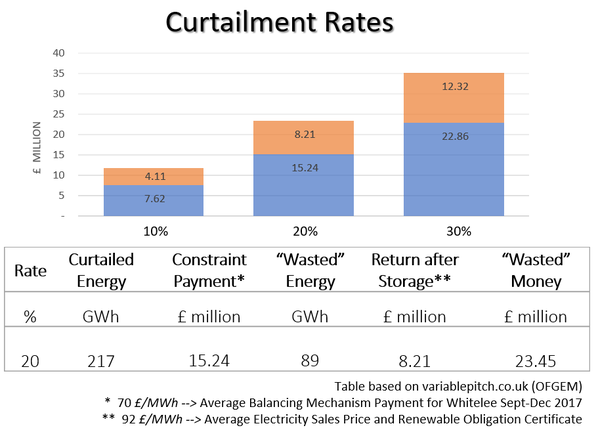How much does it cost?
The financial analysis is only scratched superficially since it is difficult to find reliable data for a new technology such as ammonia production based on renewable electricity. Furthermore, research shows that costs vary widely with the installed capacity but also with the resource of electricity. However, the economical factor is always important for the choice of a technology and likewise for the choice of a storage system. Without considering operating costs and assuming onshore wind energy as resource for the electricity the levelized costs of energy are estimated as follows.
Assuming the case of 20% curtailment, the costs for the storage capacity of each technology is quite within a comparable range. Lithium-Ion shows up as the cheapest technology but without considering converter costs and any other electrical equipment. Redox-flow batteries appear to be slightly more expensive but still cheaper than the proposed ammonia solution. However, ammonia turns out to be only 23% more expensive per provided kWh than Lithium-Ion. Including the assumption that ammonia gets cheaper with increasing scale of installed capacity the proposed solution seems to be reasonable after all.
Another important consideration is how much the curtailment costs and how much can be saved if the curtailed energy is used for resale. Assuming the amount of curtailed energy is 20% of the annual output based on the investigated model, it would be 217 GWh of not used energy. Constraint payments need to be done to meet the contracts with the wind turbine operators. This payments of £ 15.24 million are covered by the bills of the public. Including the conversion efficiency to ammonia a total amount of 89 GWh could be sold in times of high electricity costs and high demand. The price for this energy is based on OFGEM data published by “variablepitch.co.uk” and is valued at 92 £/MWh resulting in £ 8.21 million as a return after storage. Summing up the total money which is wasted if curtailed energy is not used would be £ 23.45 million. In a year with high wind occurrence and thus a higher rate of curtailment saying 30% of the annual output, the amount of wasted money would be £ 35 million.
Another important consideration is how much the curtailment costs and how much can be saved if the curtailed energy is used for resale. Assuming the amount of curtailed energy is 20% of the annual output based on the investigated model, it would be 217 GWh of not used energy. Constraint payments need to be done to meet the contracts with the wind turbine operators. This payments of £ 15.24 million are covered by the bills of the public. Including the conversion efficiency to ammonia a total amount of 89 GWh could be sold in times of high electricity costs and high demand. The price for this energy is based on OFGEM data published by “variablepitch.co.uk” and is valued at 92 £/MWh resulting in £ 8.21 million as a return after storage. Summing up the total money which is wasted if curtailed energy is not used would be £ 23.45 million. In a year with high wind occurrence and thus a higher rate of curtailment saying 30% of the annual output, the amount of wasted money would be £ 35 million.
How much can be saved?
Wind power curtailment is not only a waste of money but also a waste of valuable energy but without significant investments in storage technologies it is not feasible. Therefore, it is very important to use money in advance to build energy conversion systems such as the proposed ammonia solution to avoid wasted money in the future and to achieve the energy transition towards a sustainable world.
[1] https://onlinelibrary.wiley.com/doi/full/10.1002/aic.15660
[2] https://ammoniaindustry.com/ammonia-for-energy-storage-economic-and-technical-analysis/
[3] http://www.protonventures.com/wp-content/uploads/2017/07/Paper-Opportunities-for-small-scale-ammonia-production_ProtonVentures_HansVrijenhoef.pdf
[4] http://www.eng.ox.ac.uk/systemseng/publications/Ammonia-based_ESS.pdf
[5] https://www.variablepitch.co.uk/stations/718/
Reference image: https://buildingiq.com/blog/spikes-in-electricity-prices-place-a-costly-burden-on-australians-and-businesses/
[1] https://onlinelibrary.wiley.com/doi/full/10.1002/aic.15660
[2] https://ammoniaindustry.com/ammonia-for-energy-storage-economic-and-technical-analysis/
[3] http://www.protonventures.com/wp-content/uploads/2017/07/Paper-Opportunities-for-small-scale-ammonia-production_ProtonVentures_HansVrijenhoef.pdf
[4] http://www.eng.ox.ac.uk/systemseng/publications/Ammonia-based_ESS.pdf
[5] https://www.variablepitch.co.uk/stations/718/
Reference image: https://buildingiq.com/blog/spikes-in-electricity-prices-place-a-costly-burden-on-australians-and-businesses/

